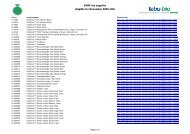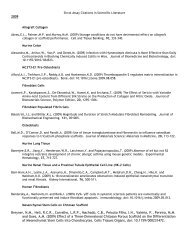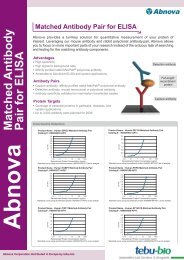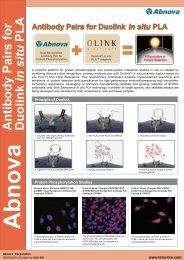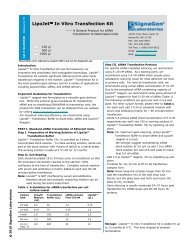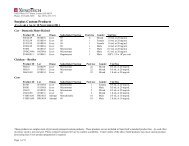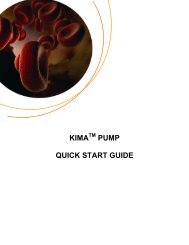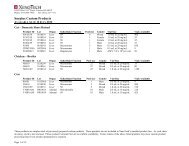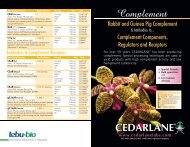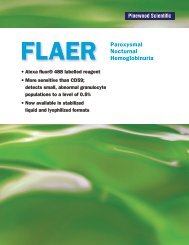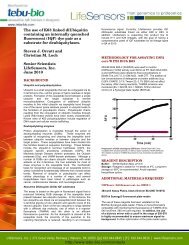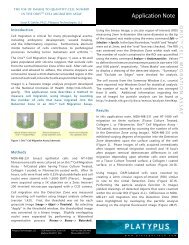Protocol for Meta-G-Nome⢠DNA Isolation Kit - Tebu-Bio
Protocol for Meta-G-Nome⢠DNA Isolation Kit - Tebu-Bio
Protocol for Meta-G-Nome⢠DNA Isolation Kit - Tebu-Bio
You also want an ePaper? Increase the reach of your titles
YUMPU automatically turns print PDFs into web optimized ePapers that Google loves.
The <strong>Meta</strong>-G-Nome <strong>DNA</strong> <strong>Isolation</strong> <strong>Kit</strong> is designed<br />
to isolate randomly-sheared, high-molecular-weight<br />
(HMW) metagenomic <strong>DNA</strong>, free of humic<br />
and fulvic acid, directly from unculturable or<br />
difficult-to-culture microbial species present in environmental<br />
water or soil samples. The <strong>DNA</strong> isolated<br />
using this kit is approximately 40 kb in size<br />
and is ready <strong>for</strong> immediate use in end-repair reactions<br />
and subsequent cloning into fosmid vectors.<br />
This protocol streamlines standard fosmid library<br />
construction by eliminating the traditional mechanical<br />
shearing and size-selection steps. Additionally,<br />
the <strong>DNA</strong> can be used as a substrate <strong>for</strong> PCR<br />
or sequencing.<br />
For increased reliability and simplicity, we recommend<br />
using the isolated <strong>DNA</strong> in conjunction with<br />
EPICENTRE's CopyControl Fosmid Library Production<br />
<strong>Kit</strong> or CopyControl HTP Fosmid Library<br />
Production <strong>Kit</strong>s.<br />
Product Specifications<br />
Storage: Store the MPC Protein Precipitation<br />
Reagent, Proteinase K, Ready-Lyse Lysozyme,<br />
RNase A, and Fosmid Control <strong>DNA</strong> at –20 o C in a<br />
freezer without a defrost cycle. Store the remainder<br />
of the kit components at room temperature.<br />
Storage Buffer: Proteinase K and Ready-Lyse<br />
Lysozyme Solution are supplied in a 50% glycerol<br />
solution containing 50 mM Tris-HCl (pH 7.5),<br />
0.1 M NaCl, 0.1 mM EDTA, 10 mM CaCl2, 0.1%<br />
Triton ® X-100, and 1 mM dithiothreitol. RNase A<br />
is supplied in a 50% glycerol solution containing<br />
25 mM sodium acetate (pH 4.6).<br />
Quality Control: The <strong>Meta</strong>-G-Nome <strong>DNA</strong> <strong>Isolation</strong><br />
<strong>Kit</strong> is function-tested by purifying <strong>DNA</strong> from<br />
1 g of garden soil, and from known concentrations<br />
of diluted E. coli in a water sample. The size of<br />
the <strong>DNA</strong> is compared with a 40-kb linear control<br />
<strong>DNA</strong> on a 1% agarose gel. <strong>DNA</strong> quality is assayed<br />
by PCR.<br />
<strong>Meta</strong>-G-Nome <strong>DNA</strong> <strong>Isolation</strong> <strong>Kit</strong><br />
Cat. No. MGN0910<br />
<strong>Meta</strong>-G-Nome <strong>DNA</strong> <strong>Isolation</strong> <strong>Kit</strong><br />
Contents<br />
The <strong>Meta</strong>-G-Nome <strong>DNA</strong> <strong>Isolation</strong> <strong>Kit</strong> provides<br />
sufficient reagents & filter membranes <strong>for</strong><br />
<strong>DNA</strong> isolations from 10 samples:<br />
Extraction Buffer ...................................500 ml<br />
Filter Wash Buffer...................................15 ml<br />
<strong>Meta</strong>-Lysis Solution (2X)* .........................3 ml<br />
MPC Protein Precipitation Reagent.......3.5 ml<br />
Proteinase K (50 μg/μl)........................... 10 μl<br />
Fosmid Control <strong>DNA</strong> (100 ng/μl) ............ 10 μl<br />
RNase A (5 μg/μl)................................... 10 μl<br />
Ready-Lyse Lysozyme Solution.......... 20 μl<br />
TE Buffer ...............................................3.5 ml<br />
(10 mM Tris-HCl [pH 7.5], 1 mM EDTA)<br />
0.45-μm Filter Membranes ......................... 10<br />
1.2-μm Filter Membranes<br />
(<strong>for</strong> soil extractions) ................................. 10<br />
- - - - - - - -<br />
*Note: The <strong>Meta</strong>-Lysis Solution (2X) may<br />
<strong>for</strong>m a precipitate during shipment or storage.<br />
If this occurs, heat the bottle at 37 o C until the<br />
precipitate dissolves. Mix thoroughly and<br />
cool to room temperature.<br />
Required materials not supplied in the kit:<br />
Filtration apparatus (Millipore or equivalent)<br />
Miracloth filtration material (Calbiochem) or<br />
sterile cheesecloth<br />
50-ml Conical tubes<br />
1.7-ml Microcentrifuge tubes<br />
Tween ® 20 (molecular biological grade)<br />
Isopropanol<br />
70% Ethanol<br />
(made from absolute ethanol)<br />
726 Post Road, Madison, WI 53713 • www.Epi<strong>Bio</strong>.com • (800) 284-8474 • (608) 258-3080 • Fax (608) 258-3088<br />
continued<br />
Lit. #303
EPICENTRE <strong>Meta</strong>-G-Nome <strong>DNA</strong> <strong>Isolation</strong> <strong>Kit</strong><br />
Related Products: The following products are also available:<br />
– CopyControl Fosmid Library Production <strong>Kit</strong><br />
– CopyControl HTP Fosmid Library Production <strong>Kit</strong><br />
– Direct Lysis Fosmid96 <strong>DNA</strong> <strong>Isolation</strong> <strong>Kit</strong><br />
– End-It <strong>DNA</strong> End-Repair <strong>Kit</strong><br />
<strong>Isolation</strong> of <strong>Meta</strong>genomic <strong>DNA</strong> from Water Samples<br />
1. To remove debris from the collected water sample (100 ml), pour the water through Miracloth filtration<br />
material (Calbiochem), sterile cheesecloth, or centrifuge at 1,000 x g <strong>for</strong> 5 minutes and collect the<br />
water in a sterile container.<br />
2. Filter the water (100 ml) through the 0.45-µm filter membrane (provided) to trap microbes onto the<br />
filter, using the appropriate filtration apparatus (e.g., Millipore, catalog no. XX1004700).<br />
3. Using <strong>for</strong>ceps and scissors presoaked in 70% ethanol, remove the membrane from the filter apparatus,<br />
cut the membrane in half, and place each half (rounded side down) along the side (near the bottom)<br />
of a 50-ml sterile conical tube. The upper surface of the filter needs to face the center (not wall)<br />
of the tube. Do not allow the filter membrane to dry out.<br />
4. Prepare the Filter Wash Buffer by adding 2 µl of Tween 20 to 1 ml of Filter Wash Buffer immediately<br />
be<strong>for</strong>e use. Add 1 ml of Filter Wash Buffer containing 0.2% Tween 20 to the filter pieces in the tube<br />
to wash off the microbes trapped on the membrane.<br />
5. Vortex the tube at the low speed setting to rewet the filter pieces, then increase the setting to the<br />
highest speed <strong>for</strong> ~2 minutes with intermittent breaks.<br />
6. Transfer the cell suspension to a clean microcentrifuge tube, then centrifuge the tube at 14,000 x g<br />
<strong>for</strong> 2 minutes to pellet the cells. Discard the supernatant.<br />
7. Resuspend the cell pellet in 300 µl of TE Buffer, then add 2 µl of Ready-Lyse Lysozyme Solution and<br />
1 µl of RNase A to the cell suspension. Mix by vortexing.<br />
8. Incubate at 37 o C <strong>for</strong> 30 minutes.<br />
9. Add 300 µl of <strong>Meta</strong>-Lysis Solution (2X) and 1 µl of Proteinase K to the tube. Mix by vortexing.<br />
10. Briefly pulse-centrifuge the tube to ensure that all of the solution is in the bottom of the tube.<br />
11. Incubate at 65 o C <strong>for</strong> 15 minutes.<br />
12. Cool to room temperature, then place on ice <strong>for</strong> 3-5 minutes.<br />
13. Add 350 µl of MPC Protein Precipitation Reagent to the tube and mix by vortexing vigorously <strong>for</strong> 10<br />
seconds.<br />
14. Pellet the debris by centrifugation <strong>for</strong> 10 minutes at 20,000 x g or at maximum speed, in a microcentrifuge<br />
at 4 o C.<br />
15. Transfer the supernatant to a clean 1.7-ml microcentrifuge tube and discard the pellet.<br />
page 2
EPICENTRE <strong>Meta</strong>-G-Nome <strong>DNA</strong> <strong>Isolation</strong> <strong>Kit</strong><br />
16. Add 570 µl of isopropanol to the supernatant. Mix by inverting the tube several times.<br />
17. Pellet the <strong>DNA</strong> by centrifugation <strong>for</strong> 10 minutes at 20,000 x g or at maximum speed, in a microcentrifuge<br />
at 4 o C.<br />
18. Use a pipet tip to remove the isopropanol without dislodging the <strong>DNA</strong> pellet. Briefly pulse-centrifuge<br />
the sample and remove any residual liquid with a pipet tip, without disturbing the pellet.<br />
19. Add 500 µl of 70% ethanol to the pellet without disturbing the pellet. Then centrifuge <strong>for</strong> 5 minutes at<br />
20,000 x g or at maximum speed, in a microcentrifuge at 4 o C.<br />
20. Use a pipet tip to remove the ethanol without dislodging the <strong>DNA</strong> pellet. Briefly pulse-centrifuge the<br />
sample and remove any residual liquid with a pipet tip, without disturbing the pellet.<br />
21. Air-dry the pellet <strong>for</strong> 8 minutes at room temperature. Note: Do not over-dry the <strong>DNA</strong> pellet.<br />
22. Resuspend the <strong>DNA</strong> pellet in 50 µl of TE Buffer.<br />
23. Validate the size and concentration of the isolated <strong>DNA</strong> by comparison to the Fosmid Control <strong>DNA</strong><br />
(40 kb; 100 ng/µl) provided in the kit, via gel electrophoresis on a 1% agarose gel. Use 2 µl of the<br />
isolated <strong>DNA</strong> preparation <strong>for</strong> this analysis.<br />
The isolated <strong>DNA</strong> is ready <strong>for</strong> PCR or <strong>for</strong> end-repair and subsequent cloning into a vector <strong>for</strong> construction<br />
of a fosmid library. If using EPICENTRE's CopyControl Fosmid Library Production <strong>Kit</strong>, proceed with endrepair<br />
(Section B, page 9) and ligation (Section E, page 13). The protocol can be found at http://www.<br />
epibio.com.<br />
For rapid preparation of template <strong>DNA</strong> <strong>for</strong> sequencing, use EPICENTRE’s Direct Lysis Fosmid96 <strong>DNA</strong><br />
Purification <strong>Kit</strong>.<br />
page 3
EPICENTRE <strong>Meta</strong>-G-Nome <strong>DNA</strong> <strong>Isolation</strong> <strong>Kit</strong><br />
A. Extraction<br />
<strong>Isolation</strong> of <strong>Meta</strong>genomic <strong>DNA</strong> from Soil Samples<br />
Be<strong>for</strong>e starting, add Tween 20 to the Extraction Buffer (1 µl Tween 20 per milliliter of Extraction Buffer) to<br />
achieve a final concentration of 0.1% Tween 20. Each extraction will use 50 ml of Extraction Buffer with<br />
Tween 20. Note: It is critical to follow the recommended centrifugal speeds as indicated in the protocol<br />
<strong>for</strong> efficient recovery of the microbes from the soil samples.<br />
1. Add 1 g of wet soil (or 200-300 mg of compost) to a 50-ml screw-cap conical tube and add 10 ml of<br />
Extraction Buffer with Tween 20.<br />
2. Mix by vortexing at maximum speed <strong>for</strong> 1 minute to disperse and dissociate the soil particles.<br />
3. Centrifuge the soil suspension at 1,600 x g <strong>for</strong> 4 minutes in a tabletop centrifuge. Pour the supernatant<br />
into a new 50-ml tube.<br />
4. Add 20 ml of remaining Extraction Buffer with Tween 20 (per extraction) to the soil pellet and mix by<br />
vortexing at maximum speed <strong>for</strong> 1 minute.<br />
5. Centrifuge the soil suspension at 900 x g <strong>for</strong> 3 minutes in a tabletop centrifuge. Important: Do not<br />
exceed 900 x g. Combine the supernatant with the previously collected supernatant.<br />
6. Reextract the soil pellet again by repeating steps 4 and 5 (above), then proceed to step 7 (below).<br />
7. Briefly centrifuge the pooled supernatant at 900 x g <strong>for</strong> 2 minutes in a tabletop centrifuge and transfer<br />
the supernatant to a fresh 50-ml tube.<br />
B. Filtration, Lysis, and Protein Precipitation<br />
1. Pour the collected supernatant (50 ml) through four layers of Miracloth filtration material (Calbiochem).<br />
2. Prefilter the sample through the 1.2-µm filter membrane provided using an appropriate filterware<br />
apparatus (e.g., Millipore, catalog no. XX1004700). Collect the filtrate.<br />
3. Pass the collected filtrate through the 0.45-µm filter membrane provided using an appropriate filterware<br />
apparatus in order to trap the microbial mass on the filter. Retain the filter membrane.<br />
4. Using <strong>for</strong>ceps and scissors presoaked in 70% ethanol, remove the membrane from the filter apparatus,<br />
cut the membrane in half, and place each half (rounded side down) along the side (near the bottom)<br />
of a 50-ml sterile conical tube. The upper surface of the filter needs to face the center (not wall)<br />
of the tube. Do not allow the filter membrane to dry out.<br />
5. Prepare the Filter Wash Buffer by adding 1.5 µl of Tween 20 to 1.5 ml of Filter Wash Buffer immediately<br />
be<strong>for</strong>e use. Add 1.5 ml of Filter Wash Buffer containing 0.1% Tween 20 to the filter pieces in<br />
the tube.<br />
6. Vortex the tube at the low speed setting to rewet the filter pieces, then increase the setting to the<br />
highest speed <strong>for</strong> ~2 minutes to wash off the microbes trapped on the filter membrane.<br />
7. Transfer the cell suspension to a clean microcentrifuge tube, then centrifuge the tube at 14,000 x g<br />
<strong>for</strong> 2 minute to pellet the cells. Discard the supernatant.<br />
8. Resuspend the cell pellet in 300 µl of TE Buffer, then add 2 µl of Ready-Lyse Lysozyme Solution and<br />
1 µl of RNase A to the cell suspension. Mix, and centrifuge briefly to bring all of the solution to the<br />
bottom of the tube.<br />
page 4
EPICENTRE <strong>Meta</strong>-G-Nome <strong>DNA</strong> <strong>Isolation</strong> <strong>Kit</strong><br />
9. Incubate at 37 o C <strong>for</strong> 30 minutes.<br />
10. Add 300 µl of <strong>Meta</strong>-Lysis Solution (2X) and 1 µl of Proteinase K to the tube. Mix by vortexing.<br />
11. Briefly pulse-centrifuge the tube to ensure that all of the solution is in the bottom of the tube.<br />
12. Incubate at 65 o C <strong>for</strong> 15 minutes.<br />
13. Cool to room temperature, then place on ice <strong>for</strong> 3-5 minutes.<br />
14. Add 350 µl of MPC Protein Precipitation Reagent to the tube and mix by vortexing vigorously <strong>for</strong> 10<br />
seconds.<br />
15. Pellet the debris by centrifugation <strong>for</strong> 10 minutes at 20,000 x g or at maximum speed, in a microcentrifuge<br />
at 4 o C.<br />
16. Transfer the supernatant to a clean 1.7-ml microcentrifuge tube and discard the pellet.<br />
17. Add 570 µl of isopropanol to the supernatant. Mix by inverting the tube several times.<br />
18. Pellet the <strong>DNA</strong> by centrifugation <strong>for</strong> 10 minutes at 20,000 x g or at maximum speed, in a microcentrifuge<br />
at 4 o C.<br />
19. Use a pipet tip to remove the isopropanol without dislodging the <strong>DNA</strong> pellet. Briefly pulse-centrifuge<br />
the sample and remove any residual liquid with a pipet tip, without disturbing the pellet.<br />
20. Add 500 µl of 70% ethanol to the pellet without disturbing the pellet. Then centrifuge <strong>for</strong> 5 minutes at<br />
20,000 x g or at maximum speed, in a microcentrifuge at 4 o C.<br />
21. Use a pipet tip to remove the ethanol without dislodging the <strong>DNA</strong> pellet. Briefly pulse-centrifuge the<br />
sample and remove any residual liquid with a pipet tip, without disturbing the pellet.<br />
22. Air-dry the pellet <strong>for</strong> 8 minutes at room temperature. Note: Do not over-dry the <strong>DNA</strong> pellet.<br />
23. Resuspend the <strong>DNA</strong> pellet in 40 µl of TE Buffer.<br />
24. Validate the size and concentration of the isolated <strong>DNA</strong> by comparison to the Fosmid Control <strong>DNA</strong><br />
(40 kb; 100 ng/µl) provided in the kit, via gel electrophoresis on a 1% agarose gel. Use 5 µl of the<br />
isolated <strong>DNA</strong> preparation <strong>for</strong> this analysis.<br />
The isolated <strong>DNA</strong> is ready <strong>for</strong> PCR or <strong>for</strong> end-repair and subsequent cloning into a vector <strong>for</strong> construction<br />
of a fosmid library. If using EPICENTRE's CopyControl Fosmid Library Production <strong>Kit</strong>, proceed with endrepair<br />
(Section B, page 9) and ligation (Section E, page 13). The protocol can be found at http://www.<br />
epibio.com.<br />
For rapid preparation of template <strong>DNA</strong> <strong>for</strong> sequencing, use EPICENTRE’s Direct Lysis Fosmid96 <strong>DNA</strong><br />
Purification <strong>Kit</strong>.<br />
Tween is a registered trademark of ICI Americas Inc., Wilmington, Delaware.<br />
Triton is a registered trademark of Rohm & Haas, Philadelphia, Pennsylvania.<br />
<strong>Meta</strong>-G-Nome, CopyControl, Ready-Lyse, and End-It are trademarks of EPICENTRE, Madison, Wisconsin<br />
page 5 2/10



